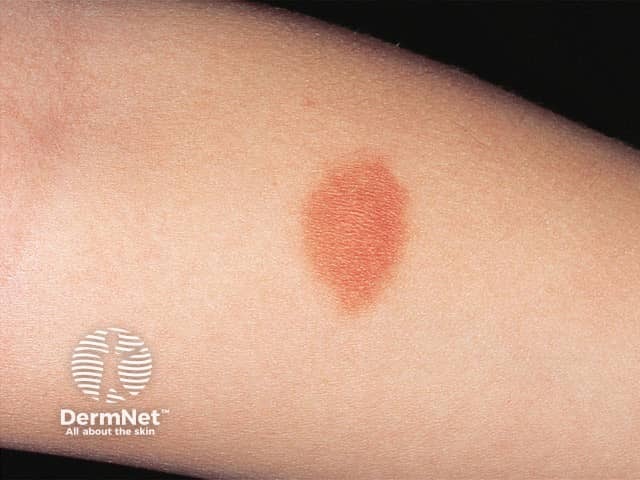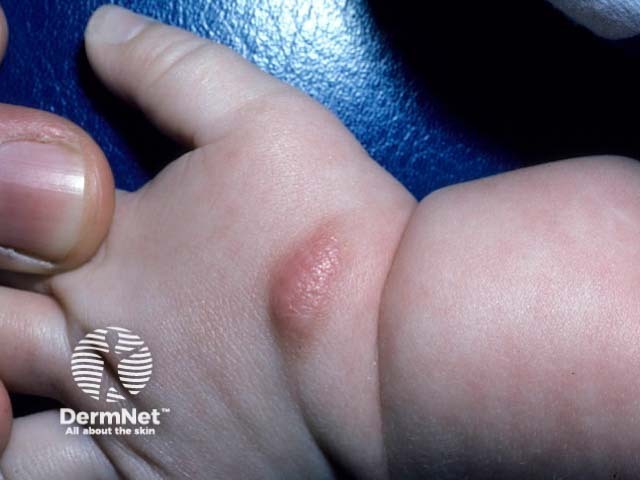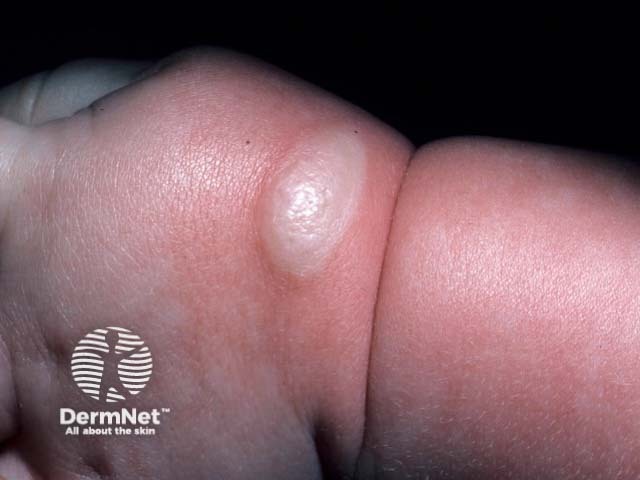Main menu
Common skin conditions

NEWS
Join DermNet PRO
Read more
Quick links
Mastocytoma — extra information
Mastocytoma
Author: Vanessa Ngan, Staff Writer, 2003. Updated by Adjunct Assoc. Prof. Amanda Oakley, Dermatologist, Hamilton, New Zealand. January 2019.
Introduction
Demographics
Causes
Clinical features
Diagnosis
Differential diagnoses
Treatment
Outcome
What is a mastocytoma?
Mastocytoma is the name given to a form of cutaneous mastocytosis in which there is a dermal accumulation of mast cells forming one to thee solitary lesions [1].

Mastocytoma

The same lesion after rubbing it
Who gets a mastocytoma?
Mastocytoma is most often diagnosed in an infant aged 0 to 3 months of age. They are rarely diagnosed in an adult [2]. Mastocytoma is not usually familial.
What causes a mastocytoma?
Mastoma has been associated with a mutation of the KIT gene, which codes for a transmembrane tyrosine receptor on the mast cell responsible for its growth and function [3].
Activation of mast cells causes them to release histamine and other chemicals, which causes localised redness, swelling, itching, and, sometimes, blistering.
What are the clinical features of mastocytoma?
One to three mastocytomas usually appear in early childhood within the first few months of age. They can occur on any site of the body
Typical characteristics of mastocytoma are:
- A firm, macule or indurated plaque 1–5 cm in diameter
- The surface may be pitted (peau d'orange appearance)
- Red, pink, yellow or brown in colour
- Intermittent itching, especially when rubbed
- Rubbing causes the lesion to urticate (redden and swell) for 15 minutes or so (a positive Darier sign). A blister may occur.
Occasionally localised or generalised flushing may occur when the mast cells release chemicals such as histamine into the skin.
Darier sign in mastocytoma

Mastocytoma

Darier sign in mastocytoma
How is mastocytoma diagnosed?
Mastocytoma can usually be diagnosed clinically, especially when a positive Darier sign is elicited. Dermatoscopy is non-specific [4], and the usual patterns seen in melanocytic naevus are absent. Blood tests are not required.
A skin biopsy reveals a monomorphous mononuclear cell infiltrate that stains positively with a c-KIT and tryptase immunoperoxidase stains [2,3].
What is the differential diagnosis with mastocytoma?
At first, it is common for symptomatic mastocytoma to be thought to be a persistent insect bite reaction. If the lesion is not itchy, a congenital or early-onset melanocytic naevus may be considered.
Four or more mast cell lesions are best described as maculopapular cutaneous mastocytosis (urticaria pigmentosa).
If Darier sign is positive in adult-onset mastocytoma, the possibility of more widespread cutaneous mastocytosis or systemic mastocytosis should be considered, especially if there are systemic symptoms such as flushing.
What is the treatment for mastocytoma?
Scratching or trauma to the lesion should be minimised to avoid itch, swelling, and blistering.
If the mastocytoma is causing a lot of itching, this can often be relieved with an oral antihistamine. Topical tacrolimus ointment has also been reported to reduce symptoms due to a mastocytoma.
A mastocytoma in a cosmetically sensitive area may be excised [3], but localised urtication may persist within the scar [2].
What is the outcome for mastocytoma?
Mastocytomas arising in infancy usually disappear before puberty [1].
References
- Leung AKC, Lam JM, Leong KF. Childhood solitary cutaneous mastocytoma: clinical manifestations, diagnosis, evaluation, and management. Curr Pediatr Rev. 2018 Nov 20. doi: 10.2174/1573396315666181120163952. [Epub ahead of print] PubMed PMID: 30465511.
- Cohen PR. Solitary mastocytoma presenting in an adult: report and literature
review of adult-onset solitary cutaneous mastocytoma with recommendations for
evaluation and treatment. Dermatol Pract Concept. 2016 Jul 31;6(3):31-8. doi:
10.5826/dpc.0603a07. eCollection 2016 Jul. Review. PubMed PMID: 27648381; PubMed Central PMCID: PMC5006550. - Ha NH, Lee YJ, Park MC, Lee IJ, Kim SM, Park DH. Solitary mastocytoma presenting at birth. Arch Craniofac Surg. 2018 Jun;19(2):127-130. doi:
10.7181/acfs.2018.01508. Epub 2018 Apr 28. PubMed PMID: 29716178; PubMed Central PMCID: PMC6057127. - Adya KA, Inamadar AC, Palit A. Dermoscopy of Cutaneous Mastocytoma. Indian Dermatol Online J. 2018 May-Jun;9(3):218-219. doi:10.4103/idoj.IDOJ_193_17. PubMed PMID: 29854655; PubMed Central PMCID: PMC5956882.
On DermNet
- Mastocytosis
- Maculopapular cutaneous mastocytosis
- Naevi (birthmarks)
Other websites
- Mastocytosis – Medscape Drugs & Diseases
